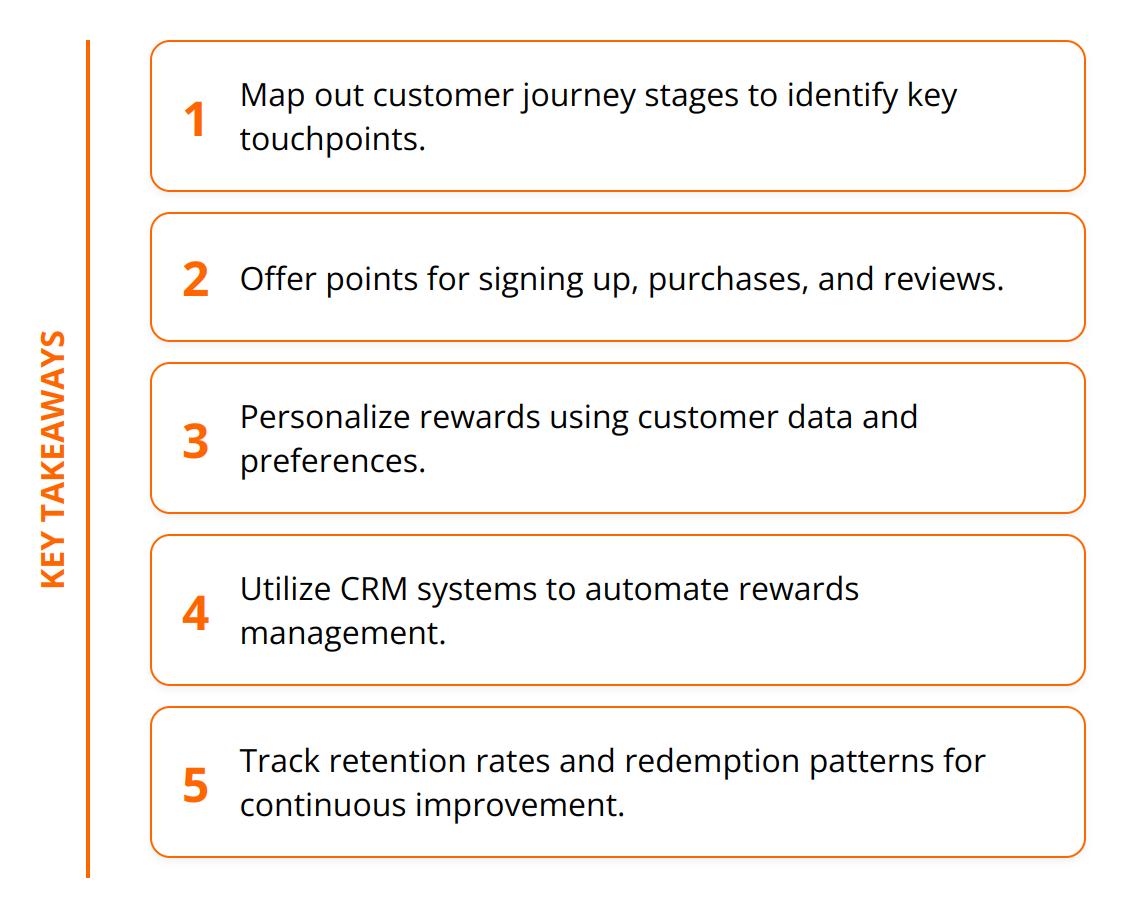
Understanding how to integrate reward points effectively can significantly transform your customer engagement.
We at Reward the World will walk you through the essentials of identifying key touchpoints, creating robust strategies, and managing your reward points program efficiently.
Boosting customer loyalty and satisfaction is within reach with the right approach which we provide you in this post: “Customer Journey Reward Points: Practical Tips”
What Are the Key Touchpoints?
To create an effective rewards points program, start by identifying the key touchpoints in the customer journey. This begins with mapping out every stage your customers go through, from initial awareness to post-purchase experience.
First, map out the customer journey stages. Consider the following phases:
- Awareness: How customers learn about your brand.
- Consideration: How they evaluate your products or services.
- Purchase: The transaction phase.
- Post-purchase: Their experience after buying.
- Loyalty: Their likelihood to return and recommend.
Next, analyze customer behavior and preferences at each stage. Gathering data on how customers interact can pinpoint moments where rewards would be most impactful. For instance, 71% of loyalty program owners have made significant changes in the past two years to better align with customer expectations.
Use analytics tools to determine which moments are most valuable. For instance, track which customer actions (such as signing up for a newsletter or making multiple purchases) are linked to higher engagement rates.
Pinpointing reward opportunities is crucial. At each touchpoint, determine how rewards can incentivize positive behavior. Examples might include offering points for:
- Signing up for newsletters
- Making first purchases
- Writing reviews
- Referring friends

Customers are 4.3 times more likely to spend annually if they redeem personalized rewards. Thus, personalizing reward offerings at these key touchpoints can significantly boost your program’s effectiveness. Additionally, trends indicate that integrating social impact into loyalty programs can increase revenue and repeat purchases.
Finally, ensure you’re continually monitoring and refining your program based on real-world performance data.

Identifying and leveraging these key touchpoints effectively can dramatically improve your rewards program, engaging customers in meaningful ways that drive long-term loyalty.
Read on customer loyalty trends
How to Create a Reward Points Strategy
Developing a robust reward points strategy can be a game-changer for increasing customer loyalty and engagement.
Setting Clear Goals and Objectives
Establishing precise goals and objectives is the cornerstone of any effective reward points program. Without clear targets, you’ll struggle to measure success and make necessary adjustments. Start by defining what you aim to achieve. Are you looking to increase customer retention by 20% over the next year? Do you want to boost average order value by 15% in the next six months? Clearly outline these objectives to guide your strategy.
Choosing the Right Reward System
Not all reward systems are created equal. Points-based rewards, tier-based systems, and cashback offers serve different purposes and have unique advantages. Points-based systems are ideal for incentivizing frequent purchases and engagement activities. Tier-based systems can provide a sense of exclusivity and motivate customers to climb higher for better rewards. It’s imperative to choose a system that aligns with your business goals and consumer behavior.

Personalizing Rewards for Increased Engagement
Personalization is no longer optional; it’s a necessity. Shoppers are 71% more likely to become repeat buyers if they feel their preferences are understood and valued. By leveraging data analytics, businesses can offer more tailored rewards that resonate deeply with their customers.
Consider incorporating user-specific data to tailor rewards. For example, if a customer frequently purchases eco-friendly products, reward them with points that can be redeemed towards similar items or donations to environmental causes. This level of personalization can elevate your program significantly.
Tips to Implement a Personalization Strategy:
- Utilize analytics tools to track customer behavior and preferences
- Segment your audience based on purchasing habits
- Offer rewards that align with individual customer values
This approach not only increases engagement but also builds a stronger emotional connection between your brand and its consumers. Real-world examples, such as Sakara Life, have shown significant customer loyalty by incorporating personalized rewards into their programs.
Creating a reward points strategy is an evolving process. Regularly revisit your goals, evaluate your reward systems, and refine personalization tactics to keep customers engaged. The right strategy can transform your customer loyalty efforts, boosting both retention and satisfaction.
How to Implement and Manage Reward Points Programs
Leveraging technology can drastically improve the efficiency of managing a rewards program. The integration of advanced analytics tools, CRM systems, and mobile apps is essential. These tools can automate tasks, track data in real-time, and provide detailed insights into customer behavior. For instance, using CRM systems can streamline reward issuance, track redemption patterns, and monitor engagement metrics.
Monitoring performance and feedback is non-negotiable. Regularly analyze key performance indicators (KPIs) such as customer retention rates, average order values, and redemption rates. Studies show that 78% of marketers acknowledge that customer engagement is data-driven. Utilize surveys and feedback loops to gather direct input from customers. This feedback is critical for identifying pain points and understanding what aspects of the program are most valued.
Continuous improvement and adaptation are key to a successful reward points program. Implement agile methodologies, allowing for quick changes based on feedback and data. Loyalty programs must evolve with changing customer expectations and market trends. Research from the loyalty management market projects an impressive growth from $6.47 billion in 2023 to $28.65 billion by 2030. This indicates the importance of staying updated with industry trends.

Practical Tips for Managing Reward Points Programs
- Use CRM systems to automate and streamline rewards management.
- Track KPIs like retention rates, average order values, and redemption rates.
- Incorporate feedback loops to gather customer input and find improvement areas.
- Adapt continually to stay relevant and meet evolving customer needs.
- E-commerce sites see a 11% increase in conversion rates when integrating social impact donations.
Implementing and managing reward points programs effectively requires the right technology, continuous monitoring, and a commitment to adaptation. Taking these steps ensures the long-term success and relevance of your rewards program. For additional insights, consider exploring practical tips on redemption rate strategies.
Conclusion
Creating a successful reward points program involves several key steps. Mapping out the customer journey, analyzing behavior at each touchpoint, and tailoring rewards to specific actions are essential. By setting clear goals and choosing the right reward system, businesses can significantly boost customer engagement.

The benefits of a well-executed reward points program include:
- Increased customer retention and loyalty
- Enhanced customer satisfaction
- Higher average order values
- Deeper emotional connection with the brand
For businesses aiming to optimize their reward systems, leveraging technology for automation, monitoring performance through data analytics, and continuously adapting to market trends are practical steps. Using CRM systems, tracking KPIs, and incorporating feedback loops are also vital.
We at Reward the World offer a dynamic global incentives platform ideal for fostering customer loyalty, increasing sales, and enhancing employee recognition. Our platform supports instant reward delivery and integrates seamlessly into your business operations.
For more insights on how to boost reward program redemption rates, check out redemption rate strategies.
Discover how Reward the World can transform your incentive programs here.
